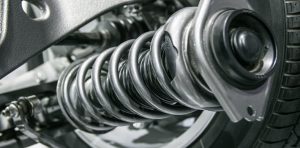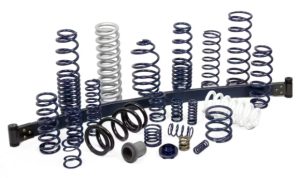Suspension springs are crucial components in any vehicle’s performance and handling, but in motorsport, their role is elevated to a precise science. Unlike standard road cars, race vehicles face extreme forces, rapid weight transfer, and high-speed cornering — all demanding highly specialized spring setups.
In this article, we explore what sets racing springs apart from everyday suspension springs, how they affect vehicle behavior on the track, and why choosing the right spring rate and construction is essential to motorsport success.
What Do Suspension Springs Do in Racing?

Suspension springs support the vehicle’s weight, absorb shocks, and maintain tire contact with the racing surface. But in racing, they serve a more nuanced role:
-
Controlling body motion under acceleration, braking, and cornering
-
Transferring grip between tires
-
Minimizing chassis roll for consistent aerodynamics
-
Allowing setup adjustability based on track and weather
Unlike in road vehicles, comfort is not a concern in racing — performance and responsiveness are everything.
Key Differences Between Racing and Street Springs
| Feature | Street Springs | Racing Springs |
|---|---|---|
| Material | Standard spring steel | High-tensile chrome-silicon or titanium |
| Spring Rate | Medium/low for comfort | High for stiffness and responsiveness |
| Adjustability | Fixed | Often fully adjustable or quick-change |
| Durability | Long-lasting, fatigue-resistant | Built for short bursts of high performance |
| Tuning Sensitivity | Basic | Precision-tuned for specific track setups |
Common Spring Rate Ranges in Motorsport
Spring rates vary significantly across motorsport disciplines. Below is a simplified guide:
| Motorsport Type | Typical Vehicle Weight (kg) | Spring Rate Range (N/mm) |
|---|---|---|
| Rally | 1200–1400 | 45–75 |
| Touring Car | 1100–1300 | 60–110 |
| Formula 3 | ~550 | 90–180 |
| Formula 1 | ~798 (FIA min weight) | 200–400+ |
| GT Racing | 1300–1400 | 70–150 |
| Drag Racing (Pro) | 1000–1400 | 100–300 (rear bias) |
Linear vs Progressive Springs in Motorsport
| Type | Description | Use in Racing |
|---|---|---|
| Linear Springs | Constant spring rate throughout compression | Most commonly used in racing setups |
| Progressive Springs | Increases stiffness with compression | Rarely used — less predictable on track |
Racers typically prefer linear springs due to their predictable behavior in high-speed environments, which helps in tuning and repeatability.
Key Considerations When Choosing Racing Springs
-
Vehicle Weight Distribution
-
Front-heavy cars may need stiffer front springs.
-
Mid-engine or rear-heavy cars require careful balance.
-
-
Track Surface & Layout
-
Bumpy tracks may need softer springs for compliance.
-
Smooth circuits allow stiffer setups for stability.
-
-
Downforce Levels
-
More aerodynamic downforce compresses springs.
-
Higher rates prevent bottoming out at speed.
-
-
Driving Style
-
Aggressive drivers may benefit from firmer setups.
-
Smooth drivers can extract more grip with softer rates.
-
Materials and Manufacturing in Racing Springs
Racing springs are typically crafted from advanced alloys and undergo precision heat treatments. Materials include:
-
Chrome-Silicon (CrSi) – High fatigue resistance and light weight
-
Titanium – Ultra-light, expensive, used in elite motorsports
-
Dual-rate Springs – Two combined spring rates in one coil, rare but used in endurance racing
High-performance springs are shot-peened and powder-coated to resist corrosion and fatigue even under extreme conditions.
Racing Spring Selection Checklist
| Question | Importance |
|---|---|
| What’s your racing category and weight rules? | Ensures legal compliance |
| What’s your car’s static and corner weight? | Essential for proper spring rate |
| How smooth or bumpy is the track? | Affects stiffness requirements |
| Are you using aero (splitters, wings)? | Influences spring compression |
| What dampers/shocks are paired with springs? | Compatibility is crucial |
| Do you need quick-change capability? | Saves time in pit adjustments |
Replacing vs Adjusting Racing Springs
In many motorsport formats, modular coilover systems are used, allowing quick replacement of springs based on:
-
Weather changes (wet races may require softer springs)
-
Track layout (more corners may demand softer springs for better grip)
-
Load adjustments (fuel load, tire changes, etc.)
Professional race teams may carry 10–20 sets of racing springs with varying rates to fine-tune setups during a race weekend.
Signs Your Racing Springs Need Replacement
-
Visible cracks or deformation
-
Sagging or uneven ride height
-
Inconsistent handling in corners
-
Unusual spring noise during compression
-
Excessive wear at coil contact points
Racing springs should be inspected regularly — after every race event or 500–1000 km, depending on use intensity.
Real-World Example: Touring Car Suspension Setup
A front-wheel-drive touring car with ~1200 kg curb weight might use:
-
Front spring rate: 90 N/mm
-
Rear spring rate: 60 N/mm
-
Adjustable dampers tuned to match
-
Anti-roll bars for roll control instead of overly stiff springs
This setup provides balance between front-end grip during braking and rear stability under power.
Where to Buy Racing Springs and Components

Choosing trusted, tested components is vital for both amateur and professional racers.
Buy Springs & Components online
Browse a wide selection of linear, performance, and motorsport springs from leading brands, tailored to your vehicle and racing discipline.
Conclusion
Racing springs are far more than just beefed-up versions of their street counterparts. They are precision-engineered tools that play a direct role in your vehicle’s lap times, responsiveness, and driver confidence.
From selecting the right spring rate and material to matching them with shocks and chassis geometry, suspension tuning in motorsport is both art and science.
Whether you’re competing in grassroots time attack or international GT events, investing in the right springs — and knowing how to use them — can be the difference between chasing the pack and leading it.
Ready to take your suspension to the next level?
Buy Springs & Components online and outfit your race car for performance, reliability, and results.